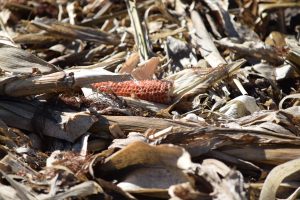Time to Assess and Take Stock of Your Soil Health
As the season approaches its conclusion and harvest conditions are most challenging, there are a few things worth remembering to protect and sustain soil health.
Compaction and Soil Water
At harvest time, soil condition is susceptible to compaction due to rain events and saturated soil conditions. Fall rain has less value to crops at this time of the year where water use by crops is negligible and there is low water evaporation as air temperature drops. This moisture condition leads to saturated soil at the top soil depths, especially in fields conventionally tilled. Such soil conditions are directly linked to the deterioration of soil structure where conventional tillage destroyed soil aggregates, resulting in reduction in water movement through the soil profile. On the other hand, a no-till system provides better, stronger and stable soil structure, which can process water deep into the soil profile to mitigate wet fall conditions and field operation’s negative effects.
This no-till core benefit along with other practices such as cover crops and residue cover are important to consider as field operations are being finalized, sustaining soil health for the upcoming season. Building soil health is a long term effort using stocked practices to rejuvenate soil functions especially in row cropping systems, where many natural and human forces and practices are in play affecting soil biological and physical properties.
Improve Your Soil Health
A few things to consider this season to improve your soil health to sustain yield, reduce soil erosion, and improve water quality:
- Monitor soil moisture conditions to make sure it is below field capacity before conducting any field operation, such as, applying nitrogen, spreading or injecting manure, seeding cover crops or attempting tillage. Soil at field capacity, where a handful of wet soil leaves noticeable moisture on your palm, is highly susceptible to soil compaction, reduction of water infiltration and an increase in surface runoff.
- Consider the use of cover crops to protect soil during the off-season. Cover crops have multiple benefits by physically protecting soil from water erosion, they stabilize soil structure through organic carbon input from the root system, and the extraction of residual nitrogen from the soil profile reducing its leaching potential to water bodies.
- Consider no-till or reduced tillage, such as, strip-tillage to keep residue on the soil surface as another measure for protecting soil and enhancing soil biological properties as an essential mechanism for healthy soil and efficient nutrient cycling.
- Lastly, consider updating your skills and knowledge on how to protect soil as your main capital or investment. Consider attending the 2019 Soil Health Conference held on February 4-5. This conference will offer a wide range of training, learning sessions and panel discussions by experts from several universities, the United States Department of Agriculture, as well as agronomists, farmers, and industry leaders.
For more information on the 2019 Soil Health Conference, consider watching this short video from our last conference or navigating to our conference website to check out the program, invited speakers and to find more registration information.
Author: Mahdi Al Kaisi, Iowa State University
Reviewers: Traci Knight, Iowa State University and Leslie Johnson, University of Nebraska – Lincoln

